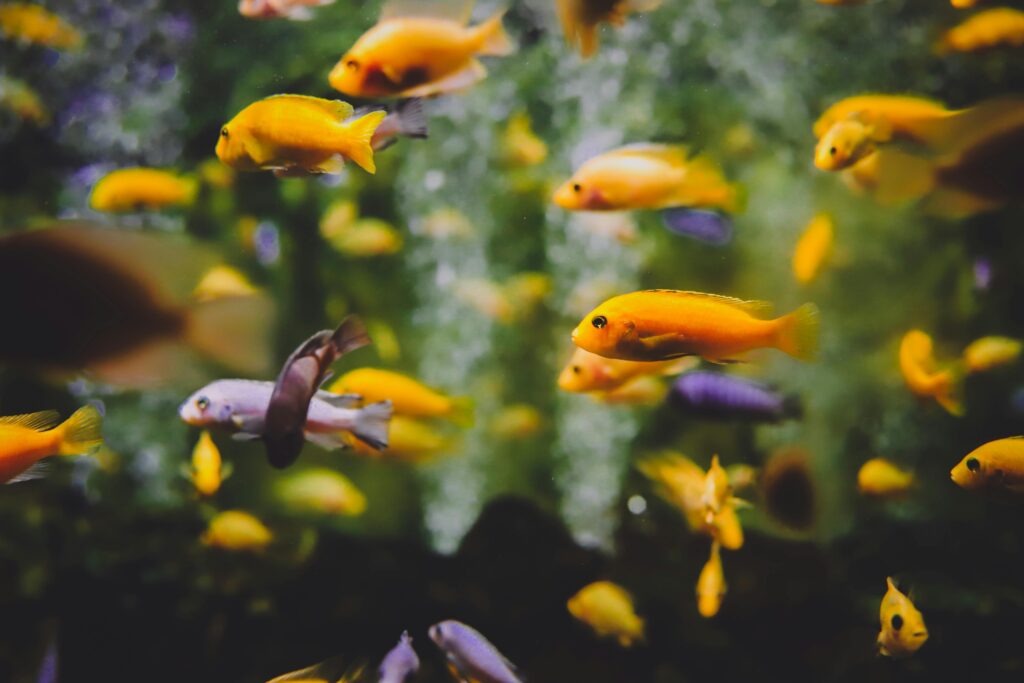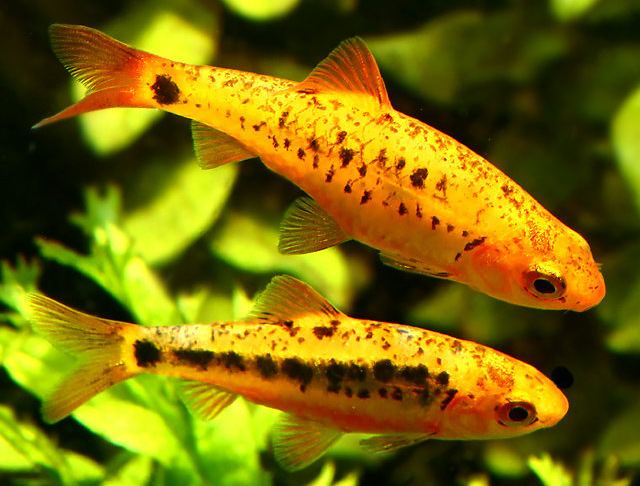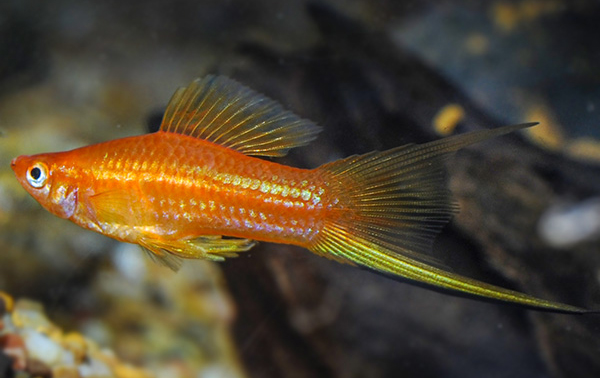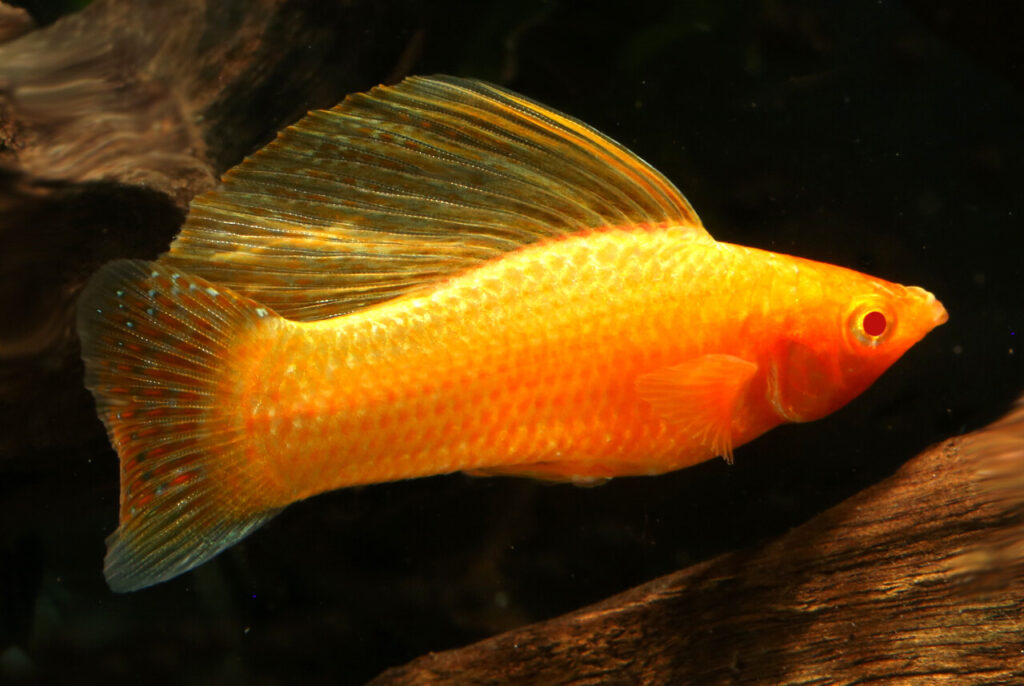A Splash of Sunshine
There’s something irresistible about yellow fish in an aquarium. Their cheerful, sunny hues bring warmth and vibrancy, transforming your tank into a living masterpiece. Whether it’s a lively school of lemon tetras or the gentle, golden shimmer of a swordtail, these radiant species captivate the eye and uplift the spirit.
Yellow fish aren’t just visually striking—they’re wonderfully diverse, ranging from peaceful schoolers to bold loners. Adding these bright beauties to your tank is like inviting rays of sunshine into your home. But which ones are the best fit for your aquarium? Let’s explore some of the most dazzling yellow fish and how to make their colors truly shine.

A lively group of yellow cichlids adds a splash of color to the aquarium. Photo: Emir Kaan Okutan
Gold Barb: A Golden Burst of Activity
The gold barb (Puntius semifasciolatus) is a vibrant and active fish that feels right at home in community aquariums. This species, originally green in its natural form, was selectively bred to develop its stunning golden color, with a sprinkling of dark speckles along its flanks. These fish are a delight to watch, darting energetically through the water and grazing on algae along the way.
Gold barbs thrive in schools, so plan for a group of at least six. Their social nature means they’re happiest with plenty of company, and a larger school will showcase their active, harmonious swimming patterns. Despite their small size—reaching a maximum of three inches—they have big personalities and can easily become the visual centerpiece of your tank.
These hardy fish are well-suited to a range of water conditions, with a pH tolerance of 6.0 to 7.8 and temperatures from 65°F to 77°F. This flexibility makes them an excellent choice for beginner aquarists. Keep in mind, however, that they can sometimes nip at slower, long-finned species like bettas. A tank with live plants and ample swimming space will allow these active little swimmers to truly shine.
Suggested Product: A quality floating food pellet helps ensure your gold barbs get the nutrients they need for vibrant coloration and energetic behavior.

Gold Barb (Barbodes semifasciolatus) – a vibrant freshwater fish known for its golden hue and peaceful nature, perfect for community aquariums. Photo: Tom Bayley
Lemon Tetras: Zesty Rays of Light
For a more subtle yet equally captivating addition, consider the lemon tetra (Hyphessobrycon pulchripinnis). These small, schooling fish bring a unique charm to aquariums, with their lemony-yellow bodies and bright red eyes that seem to glow against a backdrop of greenery. Their fins, rimmed in black, add a touch of elegance to their cheerful appearance.
Lemon tetras thrive in groups of six or more, where their natural schooling behavior takes center stage. They’re peaceful and adaptable, making them an excellent choice for community tanks. Feed them a diet rich in high-protein, color-enhancing flakes, supplemented with freeze-dried or live foods like bloodworms to maintain their vibrant hues.
To bring out their best colors, house lemon tetras in a planted tank with slightly acidic to neutral water (pH 6.2–7.5) and a temperature range of 68°F to 78°F. When given the right conditions, these little rays of sunshine will light up your tank like the first golden light of dawn.
Suggested Product: Color-enhancing flakes specifically designed for tetras can help maintain their striking yellow hues.
Golden Swordtails: A Flash of Sunshine
Swordtails (Xiphophorus hellerii) are a classic choice for aquarists looking to add a touch of yellow to their tanks. Their long, sword-like tails, particularly in males, give them a regal appearance, while their playful behavior brings life to any community tank. Available in a range of colors, the yellow and gold varieties are especially striking, often adorned with subtle patterns of silver or black.
These peaceful fish typically grow to about five inches and are highly adaptable to various tank setups. They do best in water with a neutral to slightly alkaline pH (7.0–8.4) and temperatures between 70°F and 82°F. Swordtails are also easy to breed, making them a favorite among hobbyists who enjoy raising fry.
Keep an eye on their tankmates, as swordtails’ flowing tails can sometimes attract unwanted attention from nippy fish like barbs or aggressive tetras. Providing a well-maintained, stress-free environment with stable water parameters will help prevent common health issues like fin rot or fungal infections.
Suggested Product: Aquarium salt can help create a healthier environment for swordtails by reducing stress and boosting immunity.

Golden Swordtail (Xiphophorus helleri) – a striking freshwater fish with its shimmering golden body and elegant sword-like tail, ideal for peaceful community tanks.
Golden Pristella Tetras: Subtle Sophistication
If you’re looking for a softer touch of yellow, the golden pristella tetra (Pristella maxillaris) might be the perfect choice. These petite fish are less bold than lemon tetras, with pale golden bodies and fins accented by black and white edges. Their understated beauty makes them a great complement to brighter species in a community tank.
Golden pristella tetras are incredibly hardy, thriving in a wide range of water conditions, from acidic rivers to slightly brackish estuaries. This adaptability makes them ideal for both beginner and experienced aquarists. A planted tank with plenty of hiding spots will help them feel secure, encouraging their natural schooling behavior.
Like other tetras, they do best in groups of six or more. Their diet should include high-quality flakes or small pellets, supplemented with protein-rich treats like brine shrimp or bloodworms to keep them healthy and vibrant.
Suggested Product: Freeze-dried brine shrimp are a nutritious and convenient treat for golden pristella tetras.
Yellow Sailfin Molly: Graceful Swimmers with a Sunny Glow
For aquarists seeking an elegant yet hardy addition to their tank, the yellow sailfin molly (Poecilia latipinna) is an excellent choice. With its shimmering yellow body and large, flowing dorsal fin, this species is a striking centerpiece for community tanks. Native to coastal waters and brackish estuaries of the Americas, the sailfin molly is highly adaptable, thriving in both freshwater and brackish setups.
Yellow sailfin mollies grow to about 4 inches and exhibit peaceful, social behavior. While they can coexist with a wide range of tankmates, their preference for slightly alkaline water (pH 7.5–8.5) and temperatures between 72°F and 82°F makes them ideal companions for other livebearers, such as guppies and swordtails. They are also livebearers themselves, so don’t be surprised if you find fry swimming in your tank!
To maintain their vibrant yellow coloration, a diet rich in plant-based flakes, algae wafers, and blanched vegetables like spinach is essential. These fish also benefit from the addition of aquarium salt, which mirrors the brackish conditions of their natural habitat and helps reduce stress.
Suggested Product: Algae wafers are perfect for supporting the dietary needs of yellow sailfin mollies and enhancing their brilliant yellow hues.

Yellow Sailfin Molly (Poecilia latipinna) – a vibrant freshwater fish featuring a striking golden body and a large, sail-like dorsal fin, popular among aquarium enthusiasts. Photo: Tom Bayley
Yellow Honey Gourami: The Gentle Shimmer
For a calm and peaceful addition, consider the yellow honey gourami (Trichogaster chuna). This small labyrinth fish is renowned for its delicate, honey-like coloration, which ranges from pale yellow to a deeper gold. Males often display more vibrant hues, especially during breeding, when their bellies take on a bold reddish tint.
Yellow honey gouramis are perfect for smaller tanks, growing to just about 2 inches in length. Their gentle temperament makes them ideal for pairing with other non-aggressive fish, such as tetras and rasboras. They thrive in well-planted tanks with subdued lighting, where their golden bodies can shimmer beautifully against the green backdrop.
This species prefers slightly acidic to neutral water (pH 6.0–7.5) and temperatures between 72°F and 82°F. A varied diet of high-quality flakes, micro pellets, and occasional live foods like daphnia or mosquito larvae keeps them healthy and vibrant. Their slow, deliberate movements and unique ability to gulp air at the water’s surface add a touch of grace and intrigue to any aquarium.
Suggested Product: Micro pellets are an excellent food option for yellow honey gouramis, providing balanced nutrition for their small size.
Other Yellow Options to Consider
While the species we’ve covered are among the most popular, they’re far from the only options for adding yellow hues to your aquarium. Yellow gouramis, golden mollies, and even rare yellow bettas can bring unique beauty to your tank. African cichlid keepers, in particular, will find yellow a common theme among their colorful collections. For saltwater enthusiasts, fish like the yellow tang are iconic additions to marine tanks.
Each species has its own care requirements, so be sure to research their needs before making a purchase. With careful planning, you can create a vibrant, golden aquarium that’s as stunning as it is harmonious.
The Bright Side of Aquascaping
Yellow fish bring warmth, energy, and a sense of joy to aquariums. Whether you prefer the bold patterns of a gold nugget pleco or the delicate shimmer of a golden pristella tetra, there’s a perfect yellow companion for every tank. By understanding their unique needs and providing the right environment, you’ll be rewarded with a tank that feels alive with light and color—a true living masterpiece.
Related Reading
How to Set Up Your Very First Freshwater Aquarium: A Step-by-Step Guide
